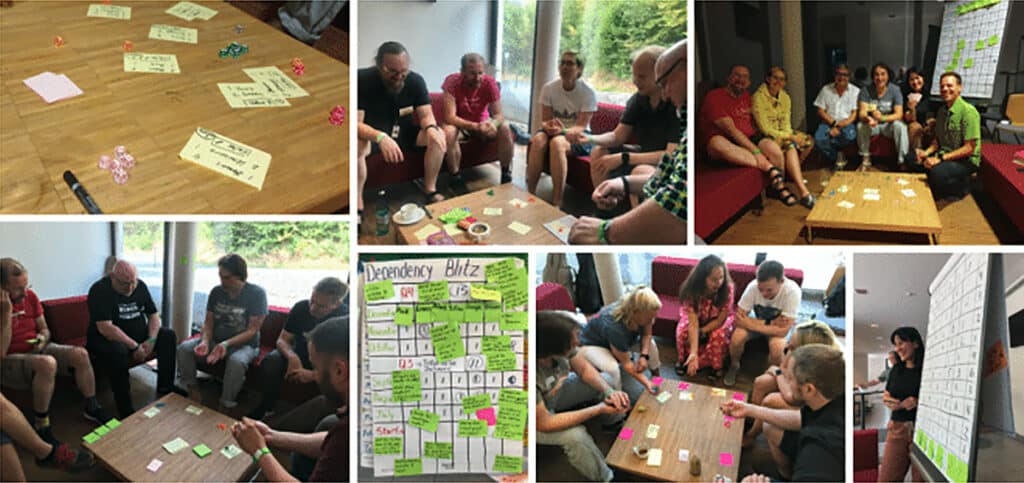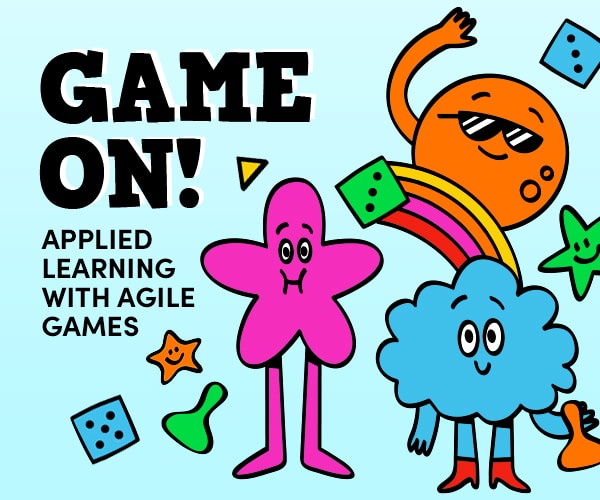Objective of the game
Find a golden path to delivering maximum business value by benefiting from collaboration vs. getting stuck in dependencies.
Number of players: 4 – 6 players
Duration: 6- 12 rounds (60 – 90 min)
Game Elements
- 30 dice (6 different colours, 5 dice each)
- 1 facilitator die
- 36 challenge cards (6 per each colour)
- 12 bonus cards
- 1 Delivery Board
Download and print the Challenge cards, bonus cards and the Delivery board.
Game setup
- If there are fewer than 6 players in the game, remove extra colours (dice and corresponding colour challenge cards)
- Distribute the dice to the players, one colour per player.
- Place challenge decks on the table, face down and bonus card deck face up.
Round one
- Set: The facilitator rolls the die to reveal the number of dependencies that the players will need to work within the first round. Players open up a corresponding number of the challenge cards and place them on the table face up.
- Plan: Players decide whether they will be working individually, collaborate on addressing dependencies or split their capacity, and attempt to do both.
- Run: Everyone rolls the dice at the same time according to the plan.
- Calculate
- Individual work: Player gets 1 business value point for rolling “1” on any of his/her dice that were allocated for this work.
- Challenge card: Group gets a full value (5 or 8 business value points) of the challenge card that they were able to solve in this round.
- Delivery board gets updated with the results and the players continue with the next round.
Note:
- Partially done cards don’t earn value and they “lock up” the partially done dice until dependency is fully solved.
- Challenge cards can have time boxes (1 month, 3 months). If this card’s dependency is not solved by the time box, the group begins to pay for the cost of delay (negative value of the card) in each round, until solved.
- Challenge cards can represent technical dependencies (indicated by a capital T in a circle). When this dependency is solved, the players have a choice: to count the value toward the total delivery OR to exchange it for one of the bonus cards.
Next rounds
- Set: If there are existing dependencies left on the table from a previous round, when a facilitator rolls the die, new dependencies are added only if the number on the die is greater than the number of pre-existing dependencies.
- Plan: Players make plans on their capacity allocation, knowing that some for their dice might be “locked up” in a partially done work from the previous round.
- Run: Players roll the dice according to the plan
- Calculate: The business value points are calculated (adjusted for the cost of delay) and recorded in the current month column on the Delivery Board
Note:
- If this round corresponds to the end of March, June, or September on the Delivery Board, the total value delivered is calculated for the quarter, and the team is invited to run a quarterly retro and planning. At this time they may choose to drop any dependencies that they haven’t started by “paying” ½ of the card value or drop any partially started dependencies by “paying” the full value of the card.
- If this is the last round(December on the Delivery Board), the total value delivered is calculated for the entire year. When the total value is calculated, the total face values of any incomplete or partially complete dependencies are deducted from the total business value delivered by the team in the previous 12 months.
Game debrief ideas
- What did you notice in our way of working? Our communication?
- How is this connected to your real-life dependency challenges?
- How did it feel to work under time-box pressure?
- What insights have emerged for you during this game?
Acknowledgments
This game emerged as an idea during a game design pre-event facilitated by Tim Yevgrashyn & Katrin Elster at the Play4Agile 2022 conference. From an idea to a playable prototype, the game evolved through rapid prototyping, daily (and evening) play testing with the help, ideas, feedback, and cheers from the group of fantastic agile game designers, who I am inspired by and very grateful to (in alphabetical order):
Marc Bless, Olaf Bublitz, Kurt Cotoaga, Martin Heider, Reinald Kirchner, Falk Kühnel, Michael Mahlberg, Christian Methfessel, Nastassia Krupiankova, Stanislava Potupchik, Markus Reinhold, Anja Steidl, Lucian Adrian Stroie, Adrian Suciu, Malte Sussdorff, Michael Tarnowski, Andreas Thier, Ilja Vishnevski, Silvana Wasitova, Tim Yevgrashyn.

What’s next?
If you’d like to get notified when a professionally printed Dependency Game is available on The Gamecrafter, add your name to this mailing list.
If you are happy to run it with your teams in a DIY version, print the files, play, and send me your feedback!






